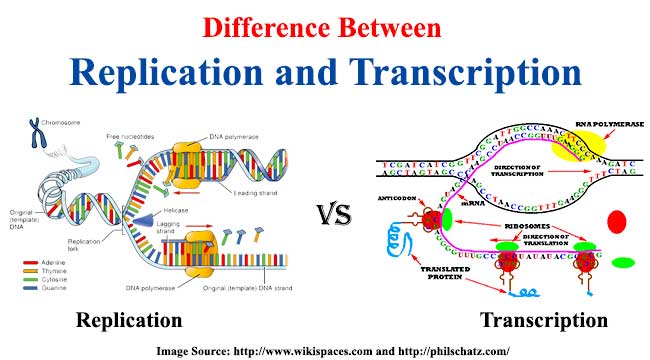Which Best Describes a Difference Between Transcription and Dna Replication
Deoxyribonucleotides are involved in DNA replication but ribonucleotides are. The right answer is ATranscription uses uracil.
What Are Some Differences Between Transcription And Dna Replication Quora
DNA replication is important for properly regulating the growth and division of cells.
. DNA replication involves synthesis of DNA molecules while transcription is a process that involves synthesis of RNA molecules. The purpose of transcription is to make RNA copies of individual genes that the cell can use in the biochemistry. This particular process takes place on both DNA strands.
The purpose of replication is to conserve the entire genome for next generation. Start studying apex bio chap 2. Replication is the duplication of strands of Deoxyribonucleic acids DNA which gives two daughter strands and each strand contains half of the original DNA double helix.
After dna replication is. The DNA and RNA molecules are chemically very close but the second has an extra oxygen in red on the right of the letters on the sugars riboses that make up its nucleotides the DNA actually contains. Transcription is the process by which DNA is copied transcribed to RNA.
Key Differences Between Replication and Transcription. Transcription is the process of synthesis of RNA using DNA as a template. In both processes DNA acts as template and provides information for synthesis of new daughter DNA or RNA strand.
Transcription does not require dna. The DNA is not tightly complexed with histones in eukaryotes. Finally the phosphodiester bonds are formed between successive nucleotides to complete the DNA strand using DNA ligase enzyme.
On the other hand DNA transcription regulates gene expression. Difference between Protein Synthesis and DNA Replication. What is the role of dna ligase in the elongation of the lagging strand during dna replication.
During dna replication a dna strand that has the bases ctaggt produces a strand with the bases. Which of the following best describes the product of dna transcription. The main difference between transcription and DNA replication is that transcription results in the formation of one-single stranded RNA molecule rather than a double -.
DNA replication is the process of making two daughter strand where each daughter strand contains half of the original DNA double helix. The chromosomes are usually circular in eukaryotes and usually linear in prokaryotes. At the end of all these steps two identical DNA strands are formed from only one mother DNA strand.
Dna replication does not use thymine. DNA replication involves three major enzymes but transcription involves only one enzyme. DNA replication involves synthesis of DNA molecules while transcription is a process that involves synthesis of RNA molecules.
Replication is a process in which two DNA are formed from a single DNA while transcription is a process in which RNA is formed from DNA. DNA replication is the process of making new copies of DNA. Which best describes a difference between transcription and dna replication.
DNA replication makes two identical DNA strands to the original strand whereas a strand of mRNA is formed according to the base sequence of a gene of the DNA strand in transcription. Learn vocabulary terms and more with flashcards games and other study tools. DNA replication is the replication of a strand of DNA into two daughter strands each daughter strand contains half of the original DNA double helix.
Eukaryotes have more origins of replication than prokaryotes. Which describes one difference between prokaryotic and eukaryotic DNA replication. It is essential in regulating the cells growth and division.
The genes carried by the DNA will be encoded in another form. Correct answer to the question Which best describes a difference between transcription and dna replication. During replication each parent dna strand serves as a _____ for synthesis of new dna strands.
Replication occurs in the S-phase of the cell cycle while transcription occurs in G1 and G2 phase of the cell cycle. DNA replication is the process of making new copies of DNA. Transcription is the process by which DNA is copied transcribed to RNA.
Transcription is the formation of only single identical Ribonucleic acid RNA from the double stranded DNA which means. The key difference between DNA replication and transcription is that DNA replication is the process of making an exact replica of the genome whereas transcription is the transfer of genetic information of a particular segment of a DNA into RNA. In both processes DNA acts as template and provides information for synthesis of new daughter DNA or RNA strand.
Transcription only takes place when a gene is turned on. Which best describes The difference between transcription and DNA replication. If the cell lacks a particular growth factor the replication process will not take place.
DNA replication is a part of cell division. Messenger RNA during a process called transcription.
What Are Some Differences Between Transcription And Dna Replication Quora

No comments for "Which Best Describes a Difference Between Transcription and Dna Replication"
Post a Comment